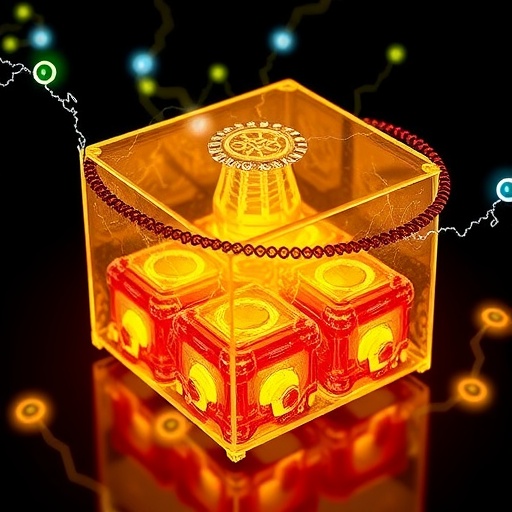A groundbreaking study led by engineers at the University of Illinois Urbana-Champaign has shed light on an often-underexplored aspect of electrochemical cells, crucial components that power a wide range of devices from mobile phones to electric vehicles. While the functions and applications of electrochemical cells—commonly known as batteries—are well understood, the intricate molecular dynamics that occur at solid-liquid interfaces have remained largely cloaked in mystery. The research team, led by Yingjie Zhang, focused on a particular phenomenon known as electrical double layers (EDLs) that form at these interfaces, which are critical to understanding the effectiveness and longevity of battery technology.
The research was motivated by the complexity and significance of electrochemical cells, which combine principles of chemistry, physics, materials science, and electronics. Though batteries are frequently viewed primarily as power sources, the latest advancements in technology necessitate a deeper comprehension of the molecular phenomena that govern their operation. By employing sophisticated microscopic imaging techniques, the researchers aimed to decode the configurations and behaviors of EDLs, which are layers consisting of electrolyte molecular arrangements that form at the interface where the liquid electrolyte meets the solid conductor. Their findings could have far-reaching implications not just for battery performance, but for the entire field of electrochemistry.
Prior investigations into electrochemical cells have recognized the heterogeneous nature of solid-liquid interfaces, noting that the chemical compositions and structural morphologies can vary significantly from one area to another. This heterogeneity can lead to the formation of surface clusters, particularly during the charging stages of a battery. Traditional studies, however, have often relied on simplified model systems featuring flat, uniform surfaces, thereby glossing over the complexities that exist in actual battery environments. The limitations of these models have left substantial gaps in the scientific understanding necessary for future advancements in battery technology.
Recognizing this knowledge gap, Zhang’s research group decided to delve into the structural dynamics of EDLs in heterogeneous environments, employing cutting-edge 3D atomic force microscopy. This advanced technique allowed researchers to observe their subjects at an extraordinary resolution, enabling them to sense the minuscule forces that dictate the behavior of EDLs. What the researchers unearthed was a nuanced interplay of molecular activity at the EDLs surrounding surface clusters, showcasing phenomena previously unobserved in such detail.
The team identified three primary responses in EDLs when subjected to surface nucleation: bending, breaking, and reconnecting. In the bending phenomenon, the EDL layers appear to curve around newly formed surface clusters. Meanwhile, in breaking, segments of the EDL detach to create intermediate layers that contribute to the evolving structure. Lastly, reconnecting involves the upper EDL layer linking to another layer adjacent to the cluster, albeit with a specific offset. These configurations are not merely incidental; they arise due to the intrinsic properties of liquid molecules rather than their chemical identity. Therefore, the researchers emphasize that it may be possible to determine liquid structures based on the morphology of solid surfaces across various systems, broadening the implications of their study far beyond the immediate scope of battery technology.
The potential applications stemming from these insights are staggering. According to Qian Ai, a graduate student and the lead author of the study, the findings open new pathways for prediction and control over EDL dynamics, which could optimize battery efficiency and lifespan. This capability is especially critical in an era where the demand for improved energy storage solutions is constantly escalating due to the rise of electric vehicles and renewable energy technologies.
Critically, this study does not merely contribute to a theoretical understanding of electrochemical processes but serves as a foundation for practical advancements that could reshape industries reliant on battery technology. Zhang posits that the resolution achieved in understanding EDLs within realistic, heterogeneous electrochemical systems may represent a “holy grail” in electrochemistry. The implications extend beyond mere technological innovation; they may well pave the way for new chapters in educational resources, guiding the next generation of engineers and scientists in their understanding of electrochemical systems.
As the researchers continue to explore their findings, they anticipate that their work will catalyze further investigations into the complex mechanisms governing electrochemical cells. This first-of-its-kind study presents profound implications not only for future battery technology but also for the broader field of materials science and engineering. The intersection of these disciplines could yield innovative approaches to tackling pressing energy challenges facing society today.
In conclusion, the groundbreaking research detailed herein serves as a vital reminder of the nuanced dynamics that dictate the behavior of electrochemical cells. The intricate interplay between solid-liquid interfaces within these systems requires a comprehensive exploration that goes beyond traditional approaches. The stunning revelations concerning EDLs—significant for both theoretical and practical applications—are a testament to the power of interdisciplinary research in tackling the complexities of modern technology. The findings are anticipated to resonate throughout the scientific community, influencing future studies and innovations within the realm of electrochemistry.
As the academic dialogue around this critical topic continues, one can only ponder the next discoveries that will emerge from this original research. Will it lead to unprecedented advancements in battery life and efficiency? Only time and further exploration will tell, but the groundwork has undoubtedly been laid for a more profound understanding of the molecular intricacies that power our everyday lives.
Subject of Research: The investigation of electrical double layers (EDLs) at solid-liquid interfaces in electrochemical cells.
Article Title: Nucleation at solid–liquid interfaces is accompanied by the reconfiguration of electrical double layers.
News Publication Date: 23-Jul-2025.
Web References: DOI Link.
References: Information related to the proceedings and the research team can be found through the provided DOI and associated academic channels.
Image Credits: The Grainger College of Engineering at the University of Illinois Urbana-Champaign.
Keywords
Materials Science, Electrochemistry, Electrical Double Layers, Battery Technology, Energy Storage, Nano-Scale Imaging, Heterogeneous Interfaces, 3D Atomic Force Microscopy.




